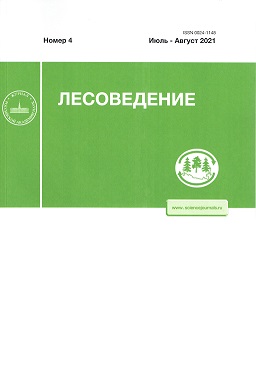ISSN: 0024-1148 Лесоведение. 2015. № 2. С. 130-139
МОДЕЛИРОВАНИЕ ГОРИЗОНТАЛЬНОГО РАСПРОСТРАНЕНИЯ КОРНЕЙ ДЕРЕВЬЕВ В РАЗЛИЧНЫХ УСЛОВИЯХ МЕСТООБИТАНИЯ
В. Н. Шанин
Институт физико-химических и биологических проблем почвоведения РАН
142290 Московская обл., Пущино, ул. Институтская, 2
E-mail: shaninvn@gmail.com
Поступила в редакцию 07.06.2013 г.
Статья посвящена анализу опубликованных данных в целях выявления основных факторов, определяющих рост корней и строение корневых систем. Установлены ключевые зависимости и собраны численные показатели по дальности распространения корней древесных растений и его связи с условиями местообитания. Регрессионный анализ позволил установить характер зависимости (логистическая функция) и ее параметры для сосны обыкновенной (Рinиs sуlvеstris L.), ели европейской (Рiсеа аbiеs (L.) Н. Каrst.), березы повислой и пушистой (Веtиlареndиlа Rоth, В. риbеsсеns Еhrh.). Сравнение коэффициентов регрессионных уравнений, полученных для данных видов древесных растений, продемонстрировало различия в их жизненных стратегиях. Установлена зависимость дальности распространения корней от типа леса и рассчитаны соответствующие корректирующие множители. Результаты будут использованы для параметризации модели корневой конкуренции, являющейся частью более крупной модели биологического круговорота биогенных элементов в лесных экосистемах.
- Работа выполнена при поддержке РФФИ (проект № 12-04-31635 и № 15-04-05400).
- Ключевые слова: корневые системы, имитационное моделирование, регрессионный анализ, конкуренция.
Список литературы
- Бобкова К.С. Строение корневых систем древесных пород в различных типах сосновых лесов Зеленоборского стационара // Труды Коми филиала АН СССР. 1971. № 24. С. 52-69.
- Верхоланцева Л.А., Бобкова К.С. Влияние почвенных условий на корневые системы древесных пород в еловых насаждениях подзоны северной тайги // Серия препринтов “Научные доклады”. Сыктывкар, 1972. Вып. 6. 56 с.
- Комаров А.С. Пространственные индивидуально-ориентированные модели лесных экосистем // Лесоведение. 2010. № 2. C. 60-68.
- Лащинский Н.Н. Структура и динамика сосновых лесов Нижнего Приангарья. Новосибирск: Наука, 1981. 272 с.
- Терехов Г.Г., Усольцев В.А. Морфоструктура насаждений и корненасыщенность ризосферы культур ели сибирской и вторичного лиственного древостоя на Среднем Урале как характеристика их конкурентных отношений // Хвойные бореальной зоны. 2010. № 3-4. С. 330-335.
- Casper B.B., Schenk H.J., Jackson R.B. Defining a plant’s belowground zone of influence // Ecology. 2003. V. 84 (9). P. 2313-2321.
- Cavard X., Bergeron Y., Chen H.Y.H., Pare D., Laganiere J., Brassard B. Competition and facilitation between tree species change with stand development // Oikos. 2011. V. 120. P. 1683-1695.
- EkA.R., Monserud R.A. Trials with program Forest: Growth and reproduction simulation for mixed species in even-or uneven-aged forest stands // Growth models for tree and stand simulation / Ed. Fries J. Stockholm: Royal College of Forestry, 1974. Research Notes 30. P. 56-73.
- Fransen B., de Kroon H., Berendse F Soil nutrient heterogeneity alters competition between two perennial grass species // Ecology. 2001. V. 82 (9). P. 2534-2546.
- Goreaud F., Loreau M., Millier C. Spatial structure and the survival of an inferior competitor: a theoretical model of neighbourhood competition in plants // Ecological Modelling. 2002. V. 158. P. 1-19.
- Grabarnik P., Loic P., Bengough G. Simulation study of the geometrical properties of a maize crop root system, and its consequences for root length density and root intersection density // Plant & Soil. 1998. V. 200. P. 157-167.
- Jackson R.B., Sperry J.S., Dawson T.E. Root water uptake and transport: using physiological processes in global predictions // Trends in Plant Science. 2000. V. 5 (11). P. 482-488.
- Jose S., Williams R., Zamora D. Belowground ecological interactions in mixed-species forest plantations // Forest Ecology & Management. 2006. V. 233. P. 231-239.
- Kalliokoski T. Root system traits of Norway spruce, Scots pine, and silver birch in mixed boreal forests: an analysis of root architecture, morphology, and anatomy. Vantaa, Finland, 2011. Dissertationes Forestales 121. 65 p.
- Kalliokoski T., Nygren P., Sievanen R. Coarse root architecture of three boreal tree species growing in mixed stands // Silva Fennica. 2008. V. 42 (2). P. 189-210.
- Kalliokoski T., Sievanen R., Nygren P. Tree roots as selfsimilar branching structures: axis differentiation and segment tapering in coarse roots of three boreal forest tree species // Trees. 2010. V. 24. P. 219-236.
- Karama S.L., Weisberg P.J., Scheller R.M., Johnson D.W., Miller W.W. Development and evaluation of a nutrient cycling extension for the LANDIS-II landscape simulation model // Ecological Modelling. 2013. V. 250. P. 45-57.
- Komarov A.S., Khoraskina Yu.S., Bykhovets S.S., Bezrukova M.G. Modelling of soil organic matter and elements of soil nutrition dynamics in mineral and organic forest soils: the ROMUL model expansion // Procedia Environmental Sciences. 2012. V. 13. P. 525-534.
- Komarov A.S., Chertov O.G., Zudin S.L., Nadporozhskaya M.A., Mikhailov A. V., Bykhovets S.S., Zudina E. V.,Zoubkova E.V. EFIMOD 2 -a model of growth and cycling of elements in boreal forest ecosystems // Ecological Modelling. 2003. V. 70. P. 373-392
- Laitakari E. The root system of pine (Pinus silvestris): a morphological investigation // Acta Forestalia Fennica. 1929. V. 33 (1). P. 1-380.
- Laitakari E. The root system of birch (Betula verrucosa and odorata) // Acta Forestalia Fennica. 1935. V. 41 (2). P. 1-217.
- Matthews R., van Noordwijk M., Gijsman A.J., Cadisch G. Models of below-ground interactions: their validity, applicability and beneficiaries // Below-ground interactions in tropical agroecosystems: concepts and models with multiple plant components / Eds. van Noordwijk M., Cadisch G., Ong C.K. Wallingford: CABI Publishing, 2004. P. 41-60.
- Puhe J. Growth and development of the root system of Norway spruce (Picea abies) in forest stands – a review // Forest Ecology & Management. 2003. V. 175. P. 253-273/
- Raynaud X., Leadley P. W. Symmetry of belowground competition in a spatially explicit model of nutrient competition // Ecological Modelling. 2005. V. 189. P. 447-453.
- Silander J.A., Pacala S.W. Neighborhood predictors of plant performance // Oecologia. 1985. V. 66. P. 256-263.
- Sperry J.S., Adler E.R., Campbell G.S., Comstock J.P. Limitation of plant water use by rhizosphere and xylem conductance: results from a model // Plant, Cell & Environment. 1998. V. 21. P. 347-359.
- Yastrebov A.B. Different types of heterogeneity and plant competition in monospecific stands // Oikos. 1996. V. 75. P. 89-97.

